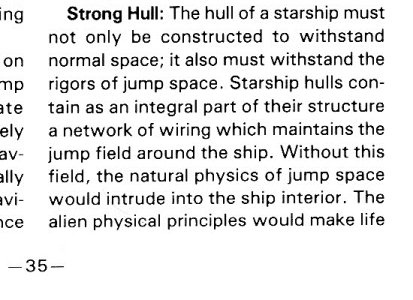Spinward Flow
SOC-14 5K
Here's a different way to think about Jump Gates.
Your standard starship has the jump drive on the INSIDE and is used to jump the starship the drive is built INTO.
Your standard jump gate has the jump drive built AROUND A SPACE and is used to jump whatever gets put IN/THROUGH that SPACE. It's basically a VERY short range jump projector (with the range measured in kilometers/almost docking proximity, rather than in light seconds/weapons ranges). That way, whatever you put into the volume of space ... jumps ... while leaving the "gate drive" behind. The "jump drive" becomes (more or less) "external" to the "starships" that can be jumped by the gates. The only difference is that when a craft "gets jumped" it doesn't take the jump drive with it (because the gate stays behind).
It's broadly analogous to a Rider/Tender arrangement, except that the "tenders" DO NOT MOVE when stuff jumps through gates.
Fun part is when you realize that the 100D limit for jump safety should still apply ... so if you've got a 100m spherical volume that you can target to jump projector into, 100*100=10km ... so your jump projector equipment is going to need to be a minimum of 10km away from the "target volume to jump" and will itself need to be 100m or less in length/major axis to prevent needing to move farther away to maintain the 100D jump safety condition into the projected space. One way to do this would be to "subdivide" the jump projector systems into multiple "satellite" (or jump "rails" if you prefer) craft that all coordinate and work together harmoniously to create a working jump projector collectively between them.

Your standard starship has the jump drive on the INSIDE and is used to jump the starship the drive is built INTO.
Your standard jump gate has the jump drive built AROUND A SPACE and is used to jump whatever gets put IN/THROUGH that SPACE. It's basically a VERY short range jump projector (with the range measured in kilometers/almost docking proximity, rather than in light seconds/weapons ranges). That way, whatever you put into the volume of space ... jumps ... while leaving the "gate drive" behind. The "jump drive" becomes (more or less) "external" to the "starships" that can be jumped by the gates. The only difference is that when a craft "gets jumped" it doesn't take the jump drive with it (because the gate stays behind).
It's broadly analogous to a Rider/Tender arrangement, except that the "tenders" DO NOT MOVE when stuff jumps through gates.
Fun part is when you realize that the 100D limit for jump safety should still apply ... so if you've got a 100m spherical volume that you can target to jump projector into, 100*100=10km ... so your jump projector equipment is going to need to be a minimum of 10km away from the "target volume to jump" and will itself need to be 100m or less in length/major axis to prevent needing to move farther away to maintain the 100D jump safety condition into the projected space. One way to do this would be to "subdivide" the jump projector systems into multiple "satellite" (or jump "rails" if you prefer) craft that all coordinate and work together harmoniously to create a working jump projector collectively between them.





